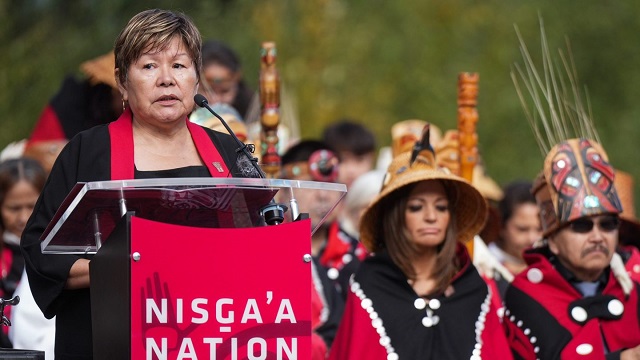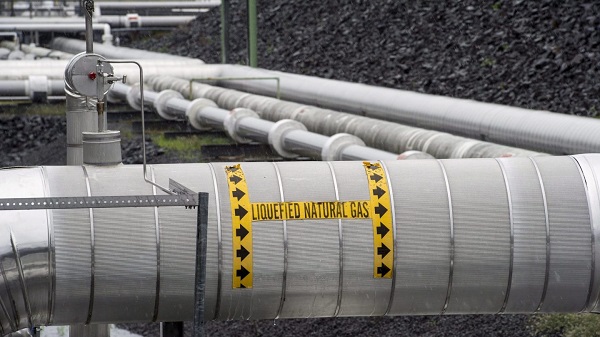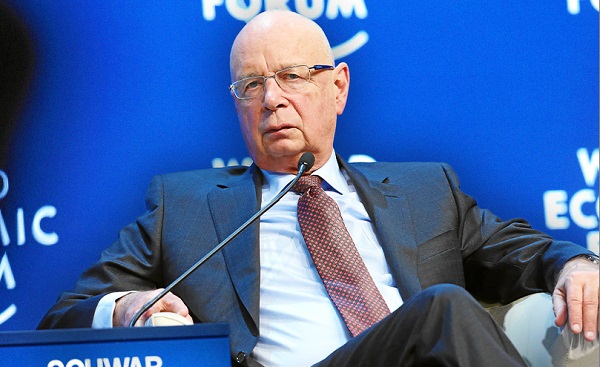Canadian Energy Centre
B.C. First Nation buying ‘ready-to-go’ natural gas pipeline to supply LNG project

Eva Clayton, president of the Nisga’a Lisims Government, speaks during a homecoming celebration for the House of Ni’isjoohl memorial totem at the Nisga’a Nation, in Laxgalts’ap, B.C., Friday, Sept. 29, 2023. CP Images photo
From the Canadian Energy Centre
By Will Gibson‘It is an opportunity for us to create a better quality of life for our children and grandchildren’
Momentum continues building for Indigenous-led Canadian liquefied natural gas (LNG), with a second project securing a pipeline connection.
The Nisga’a Nation, a small coastal community near B.C.’s border with Alaska, announced earlier this month it will purchase TC Energy’s Prince Rupert Gas Transmission project along with partner Western LNG.
It’s a turning point for the proposed Ksi Lisims LNG project, particularly because the pipeline has all the permits it needs to go ahead, said market analyst Ian Archer.
“Buying this asset, a permitted and ready-to-build natural gas pipeline, puts control in the hands of the project’s partners,” said Archer, S&P Global’s associate director for gas, power and climate solutions.
“The Nisga’a Nation and Western LNG now have control over the timeline and development of their proposed development. It’s a great day for them and the LNG industry in B.C.”
The purchase comes after years of uncertainty for the proposed 900-kilometre pipeline, which would run from Hudson’s Hope in northeast B.C. to Lelu Island, near Prince Rupert.
It was originally supposed to supply the $36-billion Pacific NorthWest LNG project, which was cancelled in 2017.
In 2014, the Nisga’a Nation signed an agreement for construction of the pipeline through its traditional lands. Today, Nisga’a president Eva Clayton says becoming an owner of the project ensures it will provide even greater benefits.
Nisga’a Nation and Western LNG to purchase PRGT natural gas projecthttps://t.co/jPVDa3jzQP pic.twitter.com/Er6ugtTlkV
— NLG – Nisga'a Nation (@NLGNisgaaNation) March 14, 2024
“This means more training, more priority hiring, more contracts and procurement for our workers and businesses, and more investment in our nation,” Clayton said.
“It is a historic development, and an opportunity for us to create a better quality of life for our children and grandchildren here in the Nass – and for First Nations all along the pipeline route.”
Ksi Lisims is a proposed floating facility with capacity to export 12 million tonnes of LNG per year. It is owned by the Nisga’a Nation, Western LNG, and Rockies LNG – a consortium that includes some of Canada’s largest natural gas producers.
Archer, who has spent more than 20 years analyzing the energy sector, sees the partnership as a template for the future.
“The trend now is Indigenous participation in energy developments is seen as a given as opposed to just engagement or consultation with communities,” he says.
“There is a recognition by both energy producers and Indigenous communities that they have a vested interest in exploring and participating in partnerships to responsibly develop oil and gas and build critical infrastructure to support that. That trend will continue to grow because it makes sense for everybody.”
The momentum is building for Ksi Lisims – which also recently signed on Shell as a long-term LNG buyer and filed its regulatory application for an environmental certificate – hot on the heels of Cedar LNG, another Indigenous-led project on the B.C. coast.
Cedar LNG, owned jointly by the Haisla Nation and Pembina Pipeline Corporation, has regulatory approval to proceed and is preparing for construction to start. A final investment decision is expected by the middle of this year.
Cedar’s pipeline is already in the ground. It will be served by Coastal GasLink, a 670-kilometre pipeline from northeast B.C. to Kitimat that was completed late last year.
The project was built primarily to feed the LNG Canada terminal, which is now more than 85 per cent complete.
Less than a kilometre of connecting pipeline – called Cedar Link – would need to be built to get gas flowing to the Indigenous-owned Cedar LNG project.
Given the appetite for LNG for potential customers in Asia (expected to drive a nearly 70 per cent increase in global demand through 2040), Clayton sees Ksi Lisims as key for providing opportunities for her community.
“For far too long, First Nations could only watch as others built generational wealth from the resources of our traditional lands. But times are changing. Our ownership role in this pipeline signals a new era for Indigenous participation in Canada’s economy.”
2025 Federal Election
Canada’s pipeline builders ready to get to work

From the Canadian Energy Centre
“We’re focusing on the opportunity that Canada has, perhaps even the obligation”
It was not a call he wanted to make.
In October 2017, Kevin O’Donnell, then chief financial officer of Nisku, Alta.-based Banister Pipelines, got final word that the $16-billion Energy East pipeline was cancelled.
It was his job to pass the news down the line to reach workers who were already in the field.
“We had a crew that was working along the current TC Energy line that was ready for conversion up in Thunder Bay,” said O’Donnell, who is now executive director of the Mississauga, Ont.-based Pipe Line Contractors Association of Canada (PLCAC).
“I took the call, and they said abandon right now. Button up and abandon right now.
“It was truly surreal. It’s tough to tell your foreman, who then tells their lead hands and then you inform the unions that those three or four or five million man-hours that you expected are not going to come to fruition,” he said.

Workers guide a piece of pipe along the Trans Mountain expansion route. Photograph courtesy Trans Mountain Corporation
“They’ve got to find lesser-paying jobs where they’re not honing their craft in the pipeline sector. You’re not making the money; you’re not getting the health and dental coverage that you were getting before.”
O’Donnell estimates that PLCAC represents about 500,000 workers across Canada through the unions it works with.
With the recent completion of the Trans Mountain expansion and Coastal GasLink pipelines – and no big projects like them coming on the books – many are once again out of a job, he said.
It’s frustrating given that this could be what he called a “golden age” for building major energy infrastructure in Canada.
Together, more than 62,000 people were hired to build the Trans Mountain expansion and Coastal GasLink projects, according to company reports.
O’Donnell is particularly interested in a project like Energy East, which would link oil produced in Alberta to consumers in Eastern and Atlantic Canada, then international markets in the offshore beyond.
“I think Energy East or something similar has to happen for millions of reasons,” he said.
“The world’s demanding it. We’ve got the craft [workers], we’ve got the iron ore and we’ve got the steel. We’re talking about a nation where the workers in every province could benefit. They’re ready to build it.”

The “Golden Weld” marked mechanical completion of construction of the Trans Mountain Expansion Project on April 11, 2024. Photo courtesy Trans Mountain Corporation
That eagerness is shared by the Progressive Contractors Association of Canada (PCA), which represents about 170 construction and maintenance employers across the country.
The PCA’s newly launched “Let’s Get Building” advocacy campaign urges all parties in the Canadian federal election run to focus on getting major projects built.
“We’re focusing on the opportunity that Canada has, perhaps even the obligation,” said PCA chief executive Paul de Jong.
“Most of the companies are quite busy irrespective of the pipeline issue right now. But looking at the long term, there’s predictability and long-term strategy that they see missing.”
Top of mind is Ottawa’s Impact Assessment Act (IAA), he said, the federal law that assesses major national projects like pipelines and highways.
In 2023, the Supreme Court of Canada found that the IAA broke the rules of the Canadian constitution.
The court found unconstitutional components including federal overreach into the decision of whether a project requires an impact assessment and whether a project gets final approval to proceed.
Ottawa amended the act in the spring of 2024, but Alberta’s government found the changes didn’t fix the issues and in November launched a new legal challenge against it.
“We’d like to see the next federal administration substantially revisit the Impact Assessment Act,” de Jong said.
“The sooner these nation-building projects get underway, the sooner Canadians reap the rewards through new trading partnerships, good jobs and a more stable economy.”
Canadian Energy Centre
First Nations in Manitoba pushing for LNG exports from Hudson’s Bay

From the Canadian Energy Centre
By Will Gibson
NeeStaNan project would use port location selected by Canadian government more than 100 years ago
Building a port on Hudson’s Bay to ship natural resources harvested across Western Canada to the world has been a long-held dream of Canadian politicians, starting with Sir Wilfred Laurier.
Since 1931, a small deepwater port has operated at Churchill, Manitoba, primarily shipping grain but more recently expanding handling of critical minerals and fertilizers.
A group of 11 First Nations in Manitoba plans to build an additional industrial terminal nearby at Port Nelson to ship liquefied natural gas (LNG) to Europe and potash to Brazil.
Robyn Lore, a director with project backer NeeStaNan, which is Cree for “all of us,” said it makes more sense to ship Canadian LNG to Europe from an Arctic port than it does to send Canadian natural gas all the way to the U.S. Gulf Coast to be exported as LNG to the same place – which is happening today.
“There is absolutely a business case for sending our LNG directly to European markets rather than sending our natural gas down to the Gulf Coast and having them liquefy it and ship it over,” Lore said. “It’s in Canada’s interest to do this.”
Over 100 years ago, the Port Nelson location at the south end of Hudson’s Bay on the Nelson River was the first to be considered for a Canadian Arctic port.
In 1912, a Port Nelson project was selected to proceed rather than a port at Churchill, about 280 kilometres north.
The Port Nelson site was earmarked by federal government engineers as the most cost-effective location for a terminal to ship Canadian resources overseas.
Construction started but was marred by building challenges due to violent winter storms that beached supply ships and badly damaged the dredge used to deepen the waters around the port.
By 1918, the project was abandoned.
In the 1920s, Prime Minister William Lyon MacKenzie King chose Churchill as the new location for a port on Hudson’s Bay, where it was built and continues to operate today between late July and early November when it is not iced in.
Lore sees using modern technology at Port Nelson including dredging or extending a floating wharf to overcome the challenges that stopped the project from proceeding more than a century ago.
He said natural gas could travel to the terminal through a 1,000-kilometre spur line off TC Energy’s Canadian Mainline by using Manitoba Hydro’s existing right of way.
A second option proposes shipping natural gas through Pembina Pipeline’s Alliance system to Regina, where it could be liquefied and shipped by rail to Port Nelson.
The original rail bed to Port Nelson still exists, and about 150 kilometers of track would have to be laid to reach the proposed site, Lore said.
“Our vision is for a rail line that can handle 150-car trains with loads of 120 tonnes per car running at 80 kilometers per hour. That’s doable on the line from Amery to Port Nelson. It makes the economics work for shippers,” said Lore.
Port Nelson could be used around the year because saltwater ice is easier to break through using modern icebreakers than freshwater ice that impacts Churchill between November and May.
Lore, however, is quick to quell the notion NeeStaNan is competing against the existing port.
“We want our project to proceed on its merits and collaborate with other ports for greater efficiency,” he said.
“It makes sense for Manitoba, and it makes sense for Canada, even more than it did for Laurier more than 100 years ago.”
-

 2025 Federal Election2 days ago
2025 Federal Election2 days agoOttawa Confirms China interfering with 2025 federal election: Beijing Seeks to Block Joe Tay’s Election
-

 2025 Federal Election2 days ago
2025 Federal Election2 days agoBREAKING: THE FEDERAL BRIEF THAT SHOULD SINK CARNEY
-

 2025 Federal Election2 days ago
2025 Federal Election2 days agoHow Canada’s Mainstream Media Lost the Public Trust
-

 2025 Federal Election2 days ago
2025 Federal Election2 days agoReal Homes vs. Modular Shoeboxes: The Housing Battle Between Poilievre and Carney
-

 2025 Federal Election2 days ago
2025 Federal Election2 days agoCHINESE ELECTION THREAT WARNING: Conservative Candidate Joe Tay Paused Public Campaign
-

 Media1 day ago
Media1 day agoCBC retracts false claims about residential schools after accusing Rebel News of ‘misinformation’
-

 John Stossel2 days ago
John Stossel2 days agoClimate Change Myths Part 2: Wildfires, Drought, Rising Sea Level, and Coral Reefs
-

 Business1 day ago
Business1 day ago‘Great Reset’ champion Klaus Schwab resigns from WEF










